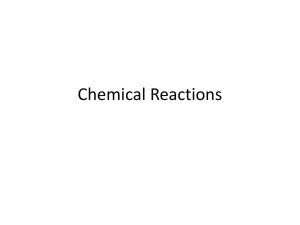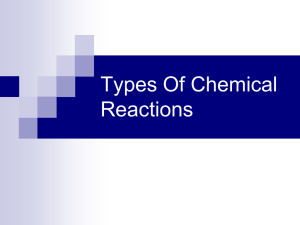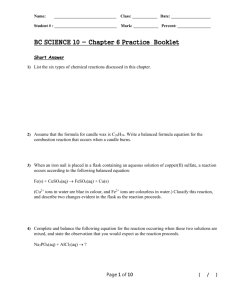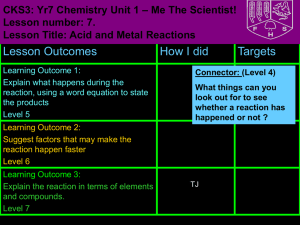File
advertisement
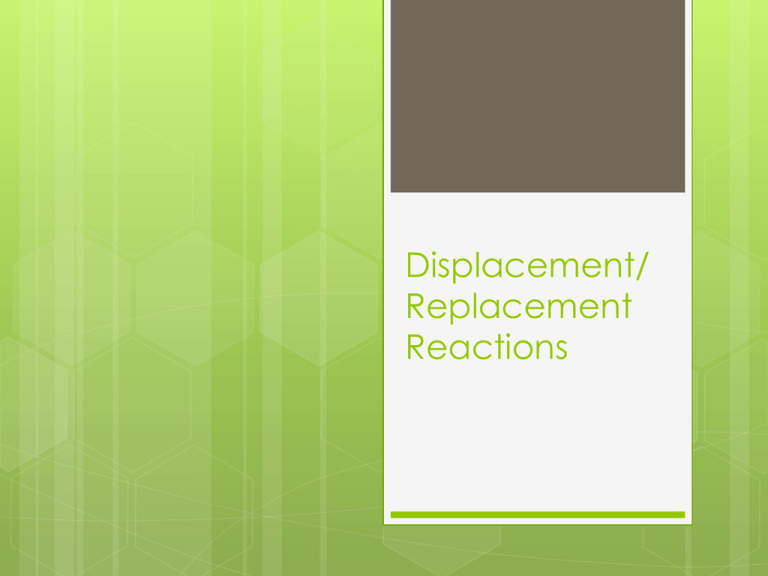
Displacement/ Replacement Reactions What is Single Replacement? When one element replaces another element in a compound, a single replacement (also known as displacement) reaction has taken place. Ex. Cl2 + 2NaBr 2NaCl + Br2 Activity Series A single replacement reaction will only take place if a more reactive metal or halogen is replacing a less reactive one. In order to know if one element is more reactive than another, we must look at an activity series chart An activity series is a ranking of relative reactivity of metals and halogens in displacement reactions. The most reactive elements are at the top of the activity series, and as you go down the chart the elements become less reactive. Single Replacement Reversibility Just because a formula is written doesn't necessarily mean the reaction can take place. Single Replacement reactions can not be reversed. Ex. Cl2 + 2NaBr --> 2NaCl + Br2 2NaCl + Br2--> Cl2 + 2NaBr will happen will not happen **Chlorine is stronger than bromine** Activity Series Practice Determine IF the following reactions will take place (YES/NO) 1. K + H2O YES 2. Cu + H2SO4 NO 3. FeCl2 + Zn YES 4. Copper (II) sulfate + chromium YES 5. Magnesium + water NO 6. Lead (II) chloride + fluorine YES Predicting Products of a Single Displacement Reaction If the reaction takes place, one of three scenarios take place 1. a halogen (group 17) replaces another halogen 2. a metal replace another metal 3. a metal replaces hydrogen (in an acid or water) An acid is just an ionic compound with hydrogen (Ex. H2SO4) When a metal replaces hydrogen in water, you need to think of water as “hydrogen hydroxide, H+ OH-” Predicting Halogen Replacement Predicting from names: When a halogen replaces another halogen, the names just switch places on the right side Ex. sodium bromide + chlorine sodium chloride + bromine Don’t confuse –ide (in a compound) with –ine (pure element) Predicting from formulas: Both sides will not have the same number of atoms until balanced since pure halogens are diatomic To not confuse yourself, you can convert formula to name before figuring out the right side Ex. NaBr + Cl2 NaCl + Br2 (NOT: NaCl2 + Br) Practice: 1. magnesium chloride + fluorine 2. KI + F2 (answer is NOT KF2 + I) (HINT: If it helps, find the answer in words then convert to formula) Predicting Metal/Metal Replacement Predicting from names: Again, the names just switch places and you don’t have to worry about suffixes Ex. calcium chlorate + sodium sodium chlorate + calcium Predicting from formulas: Both sides will not necessarily have the same number of atoms until balanced because metals with different charges will combine in a different ratio To not confuse yourself, you can convert formula to name before figuring out the right side Ex. Ca(ClO3)2 + Na NaClO3 + Ca Practice: 1. Chromium (III)phosphate + zinc 2. Al(SO4)3 + Fe(II) (Ca2+ vs. Na+) (HINT: If it helps, find the answer in words then convert to formula) Predicting metals replacing hydrogen Predicting from names: Again, the names just switch places If the hydrogen is in water, think of water as hydrogen hydroxide Ex 1. barium + water barium hydroxide + hydrogen Ex 2. aluminum + hydrogen sulfate aluminum sulfate + hydrogen Predicting from formulas: Both sides will not necessarily have the same number of atoms until balanced because metals with different charges will combine in a different ratio To not confuse yourself, you can convert formula to name before figuring out the right side Ex 1. Ba + H2O Ba(OH)2 + H2 Ex 2. Al + H2SO4 Al2(SO4)3 + H2 Practice: 1. Potassium + water 2. Zn + HCl (Ba2+ vs. H+) (Al3+ vs. H+) Double Displacement/Replacement Reactions Occurs by mixing together two aqueous solutions 2 types: precipitation reaction 1. 2. forming a solid from 2 solutions acid/base neutralization reaction forming H2O from an acidic and a basic solution Precipitation Reactions A solid ionic precipitate (salt) is formed from two ionic aqueous solutions When predicting the products in the reaction, the ions switch places Ex. silver nitrate + sodium chloride silver chloride + sodium nitrate Ex. AgNO3 + NaCl AgCl + NaNO3 A reaction will only happen if one of the products are insoluble in water Solubility is determined by referencing the products on a solubility chart The insoluble product will say either A, P or I on the chart If none of the products say either A, P or I on the chart, there is NO REACTION, the new solution created is just a homogenous mixture of the reactants Practice: Which product is the precipitate in the example reaction above? Neutralization Reaction Water is formed from an acid and a base Acids contain H+ Bases contain OH- Ex. hydrogen chloride + sodium hydroxide sodium chloride + hydrogen hydroxide (water) Ex. HCl + NaOH NaCl + HOH (H2O) Acids and bases always cancel each other out so there will always be a reaction taking place



